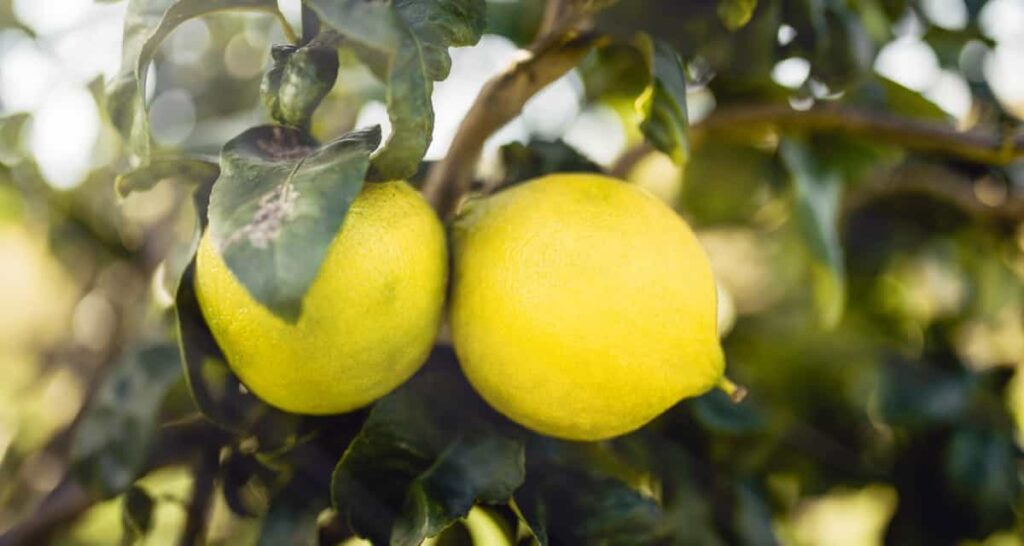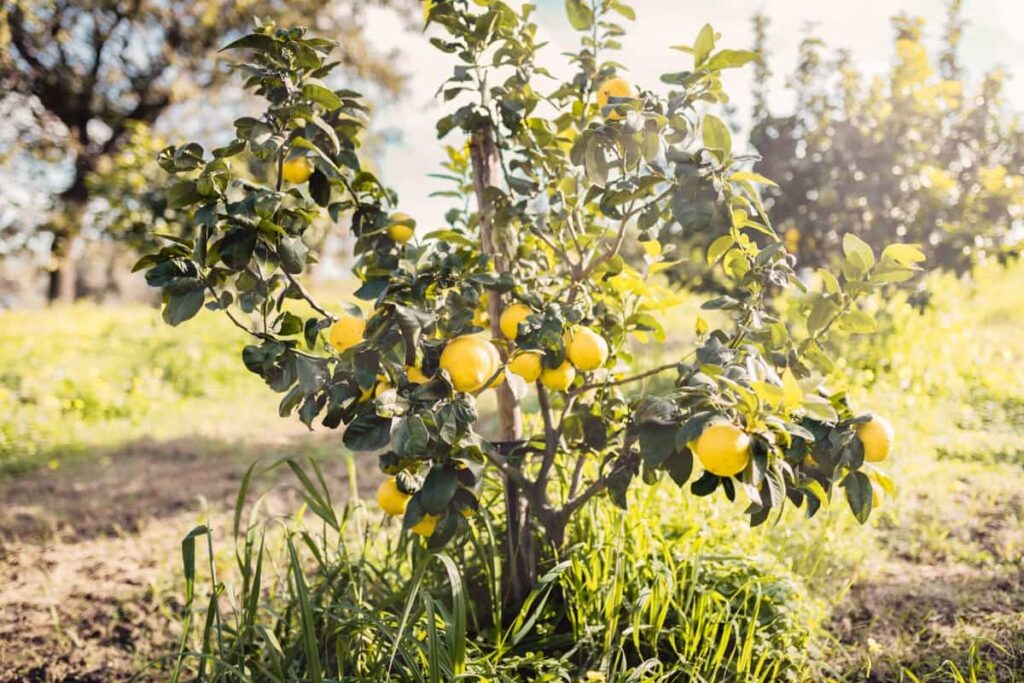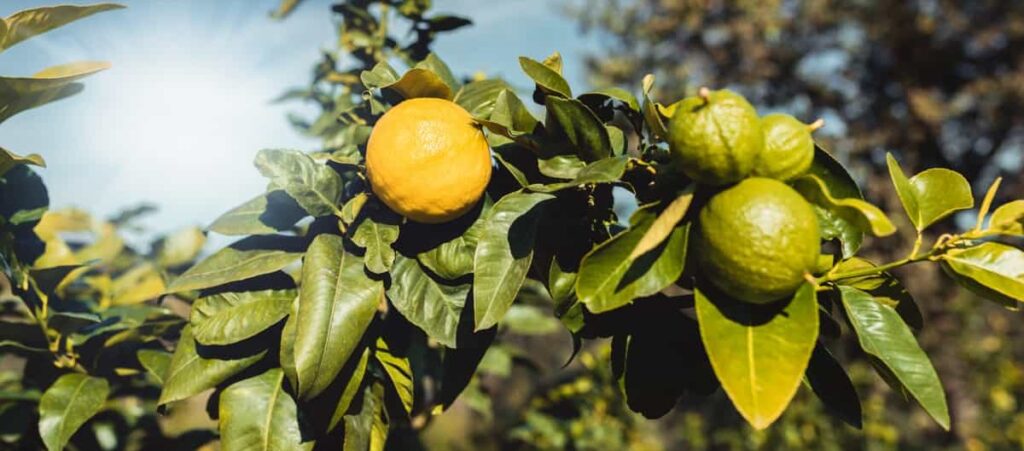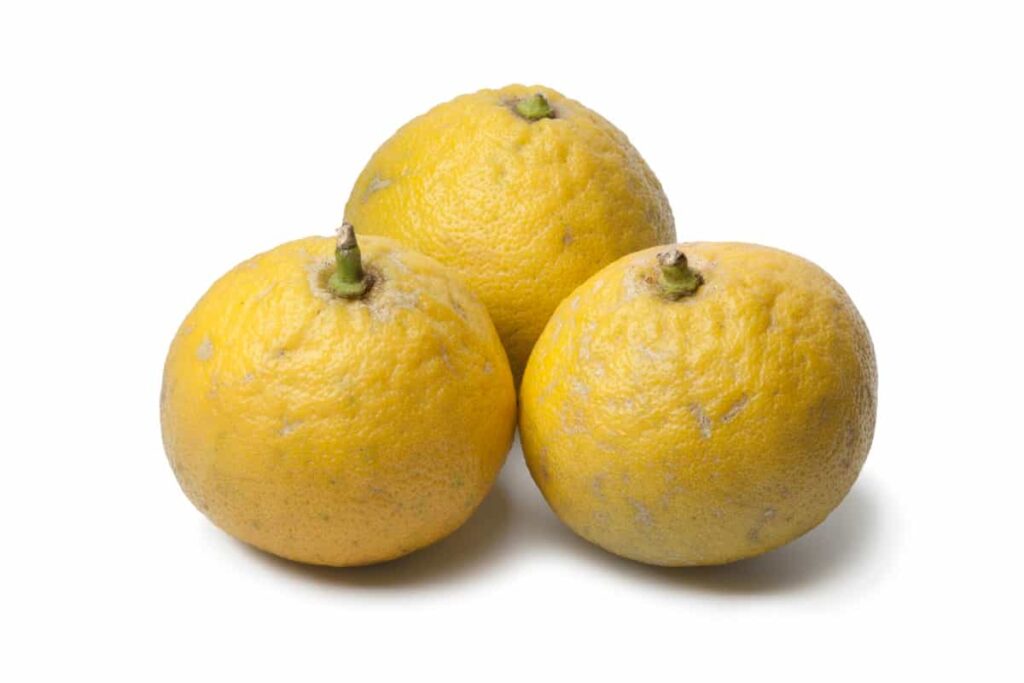The Bergamot Orange (Citrus bergamia) belongs to the Citrus plant genus in the rue family (Rutaceae). Bergamot Oranges, also known as Citrus bergamia, is a hidden gem in the citrus world. Originating from Southeast Asia, these fruits boast a unique yellow or green hue reminiscent of limes but pack a distinctive aroma that sets them apart. The fragrant oil extracted from Bergamot peels is often used in perfumes and aromatherapy for its calming properties.

Growing Bergamot Oranges
Bergamot Orange Profile
| Attribute | Description |
| Scientific Name | Citrus bergamia |
| Origin | Southeast Asia |
| Type | Citrus fruit |
| Appearance | Small Orange, and somewhat pear-shaped with a barely conical top and rounded base |
| Taste | Juice tastes less sour compared to lemon but more bitter than grapefruit |
| Texture | The yellow color rind has a slightly rough texture |
| Tree Size | About 10 to 16 feet |
| Growing Zones | Zones 9 through 11 |
| Seasonality | Available in the early fall through winter |
| Culinary Uses | Preserved in jams or marmalades |
| Storage | Kept in the refrigerator, they will last for around 2 weeks |
Choosing the Right Variety
There are several varieties of Bergamot Oranges available, each with its unique characteristics and requirements. Consider factors such as climate conditions in your region, desired fruit size, and flavor profile when selecting a variety. Some popular varieties include Castagnaro, Fantastico, and Femminello.
It’s essential to research each variety thoroughly before deciding to ensure it aligns with your specific needs and preferences. Take into account factors like tree size, growth habits, and cold hardiness. Consulting with local experts or nurseries can also provide valuable insights into which Bergamot Orange variety would thrive best in your area.
Planting Your Tree
Timing: Plant during the spring or fall when the weather is mild and not extreme. Select a sunny place with well-draining soil for optimal growth. Bergamot Oranges thrive in full sunlight, so make sure to find a place with plenty of direct sunlight.
Location: When it comes to growing Bergamot Oranges, selecting the right place is crucial for the health and productivity of your tree. These citrus fruits thrive in warm, sunny climates, so make sure to plant your tree in a spot that receives plenty of sunlight daily. Avoid regions with strong winds that can damage the delicate tree branches and leaves. Additionally, consider planting your Bergamot Orange tree in a location with good air circulation to prevent diseases from developing.
Soil: Choosing the right soil for your Bergamot Orange tree is important to its growth and fruit production. The ideal soil should be well-draining, slightly acidic, and rich in organic matter. Sandy loam or loamy soils are perfect for Bergamot Oranges as they allow water to drain easily while retaining moisture for the roots. Adding well-rotted manure before planting can provide essential nutrients for your tree’s growth.
Propagation Methods
Propagation methods are essential for growing Bergamot Oranges successfully. One common method is through seeds, which can be collected from mature fruits and planted in well-draining soil. Another way to propagate Bergamot Oranges is through cuttings taken from healthy branches during the spring or early summer months.
In case you missed it: The Ultimate Guide to Growing Iyokan Oranges: Best Farming Practices for Beginners

Before planting seeds or cuttings, it’s important to ensure they are placed in a warm and humid environment to encourage root development. This can be achieved by using a propagation box or covering them with plastic wrap. Once roots have formed, the new plants can be transferred into individual pots filled with nutrient-rich soil.
Watering and Mulching
Watering is essential, especially during the summer season when the soil can dry out quickly. To keep your Bergamot Orange tree healthy, make sure to water deeply. Mulching around the tree base helps retain moisture in the soil, reduces weed competition, and improves overall soil health. Using organic mulch can help to prevent erosion. Remember not to overwater the orange tree, as this can affect root rot and other issues. Observe the soil moisture levels and adjust the watering schedule accordingly.
Fertilizing
Fertilizing your Bergamot Orange tree is crucial for its growth and fruit production. Choose a balanced fertilizer specifically formulated for citrus trees to provide essential nutrients. Nitrogen, phosphorus, and potassium are key elements to promote healthy foliage and fruit development.
During the growing season, apply fertilizer every 4-6 weeks from spring to early fall. Be mindful not to over-fertilize, as it can lead to nutrient imbalances or burn the roots. Water your tree thoroughly after fertilizing to help nutrients reach the roots effectively. Organic options like compost or well-decomposed manure can also be beneficial for long-term soil health.
Pruning and Training
Tree pruning helps remove dead or diseased branches, improves air circulation, and promotes new growth. It also shapes the tree for better sunlight exposure, which is crucial for healthy fruit development. Training your Bergamot Orange tree involves guiding its growth by shaping it in a way that makes harvesting easier and allows for proper nutrient distribution throughout the plant.
Pest and Disease Management
Pest and disease control is a major aspect of growing Bergamot Oranges to ensure the health and productivity of your trees. Keeping an eye out for common pests like aphids, scale insects, and spider mites is essential. Regularly inspecting the leaves, stems, and fruit can help you catch any infestations early on. One natural way to control Bergamot Orange pests is by introducing beneficial insects that feed on harmful bugs. Additionally, practicing good garden hygiene by keeping the area around your trees free of debris can prevent pest outbreaks.
When it comes to diseases, Bergamot Orange trees are susceptible to fungal infections like citrus canker and root rot. Proper irrigation practices and adequate airflow between plants can help reduce the diseases taking hold. If you do notice disease or pest damage signs on your Bergamot Orange tree, promptly remove affected plant parts and consider using organic sprays or treatments as needed. By staying vigilant and proactive in managing pests and diseases, you can help your Bergamot Orange trees thrive.
When and How to Harvest
When your Bergamot Oranges have reached maturity, it’s time to harvest them. Look for a deep green or yellow color and a slightly soft feel when gently squeezed – those are signs of ripeness. To harvest Bergamot Orange fruits, twist the fruit off the branch with a gentle motion. Be careful not to damage the tree or other fruits nearby. It’s best to pick Bergamots in the morning when temperatures are cooler to preserve their flavor and aroma.
In case you missed it: 20 Steps to Grow Mandarin Oranges in Season from Seeds, Fruit, indoors, and Pots

Winter Care
Proper winter care can help protect your tree from frost damage and promote healthy growth come spring. One crucial aspect of winter care is to provide adequate insulation for your Bergamot Orange tree. Consider wrapping the trunk with protective material to shield it from harsh winds. Additionally, make sure to water your tree appropriately during the winter months. While Bergamot Oranges are relatively drought-tolerant, they still need some moisture to survive the cold season.
Growing in Containers
Growing Bergamot Oranges in containers can be a great option for those with limited space or wanting more control over their plant’s environment. When selecting a container, choose one that is large enough to accommodate the roots and has proper drainage holes at the bottom. Opt for a well-draining potting mix specifically formulated for citrus plants.
Ensure your container-grown Bergamot Orange tree receives ample sunlight each day, ideally 6-8 hours. Water consistently, allowing excess water to drain out freely to prevent root rot. Fertilize the Bergamot Orange tree regularly during the growing season with a balanced fertilizer. Keep an eye out for pests and diseases, treating them promptly if detected.
Common Challenges
One common challenge faced by growers is pest infestations, such as aphids or mites, which can damage the leaves and fruits of the tree if not managed promptly. Environmental factors like extreme temperatures or inadequate sunlight can also impact the health of your Bergamot Orange tree.
It’s important to provide optimal growing conditions to ensure a thriving crop. Fluctuations in water supply or nutrient deficiencies may hinder the growth of your tree. Regular watering and fertilizing routines are crucial for maintaining healthy Bergamot Oranges throughout their growth cycle.
Yield
A mature Bergamot Orange tree can yield up to 120 kg per tree per season. This means enjoying a bountiful harvest of fragrant citrus for making essential oils, flavoring teas, or adding a unique taste to your creations.
In case you missed it: How to Use Banana Trees as Mulch for Plants and Crops

Conclusion
The Bergamot Orange is not only visually striking but also carries a delightful scent that sets it apart from other citrus varieties. Its versatility extends beyond culinary uses; this fruit is highly valued for its essential oils in perfumery and aromatherapy.
- Crops Grown in Summer Season: Best Choices for Summer Gardening
- Organic Pest Control for Tomato Farming
- How to Maximize Sheep Farming Profit
- Broccoli Varieties: Choosing the Right Cultivars for Your Farm
- How to Raise Pigs in Your Own Backyard: A Comprehensive Guide
- Budget Friendly Sheep Shed Ideas: Cheap and Low-Cost Tips
- How Much Do Cattle Farmers Make: Revenue Streams in Cattle Farming
- Management Pests and Diseases in Your Cotton Field
- Sheep Farming Business Plan for Beginners
